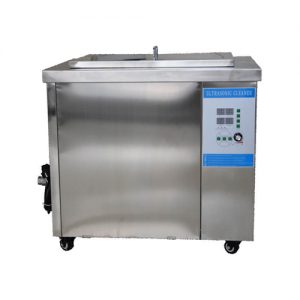An ultrasonic cleaner refers to a device that utilizes ultrasonic wave to clean surfaces of objects. The ultrasonic cleaning (USC) is a kind of unique technology for high-quality cleaning. It is usually regarded as the safest and most effective way for cleaning objects. So how does an ultrasonic cleaner work?

What is Ultrasonic?
There are three kinds of waves, which are infrasonic wave, sonic wave and ultrasonic wave respectively. The frequency of infrasonic wave is under 20Hz. The frequency of sonic wave is between 20Hz and 20KHz. But the ultrasonic wave is above 20KHz. Among them, the infrasonic wave and the ultrasonic wave can’t be heard by general people’s ears. The reasons why an ultrasonic cleaner is designed are that ultrasonic wave has a high frequency and short wavelength.
Working Principle of an Ultrasonic Cleaner
The ultrasonic cleaning (USC) functions directly or indirectly on the liquid and dirt by making use of the cavitation, acceleration and direct inflow action of ultrasonic in the liquid, making the dirt layer disperse, emulsify and strip to achieve the purpose of cleaning. The cavitation and direct inflow are more widely used in current ultrasonic cleaners.
Specifically speaking, the ultrasonic generator can send out high frequency oscillation signal, which can be converted to high frequency mechanical oscillation by the ultrasonic transducer. Then the high frequency oscillation can spread to the cleaning liquid, making the liquid flow to produce a large number of bubbles. These bubbles will cover the surfaces of objects and surround them layer by layer. At a certain pressure level, the bubbles will burst, thus removing dirt, rust and other contaminants on the surfaces of objects. This is the cavitation principle.
What is Cavitation in Ultrasonic?
The cavitaion effect means that ultrasonic transmits to liquid by means of high frequency transmission mode of compression force and decompression force interaction over 20,000 times per second. Under the function of decompression force, the phenomenon of vacuum nuclear group bubbles is generated in the liquid. Under the function of compression force, The vacuum nuclear group bubble can generate a strong impact force when it is crushed under pressure so that the dirt on the surface of the object to achieve the purpose of precise cleaning.
Working Process of an Ultrasonic Cleaner
The ultrasonic cleaning process can be roughly described as follows:
- Place the objects that need clean into the cleaning basket, and then put the cleaning basket into the cleaning tank. Don’t place the objects directly into the cleaning tank, which will damage the equipment and influence the cleaning effect.
- Pour in the cleaning liquid, such as water or other liquids, in proportion according to various objects and cleaning effects. The water level shouldn’t lower than 60mm, but not exceed 80mm.
- Start up the ultrasonic cleaner. Turn on the temperature controller for temperature regulation based on the cleaning requirements of objects.
- When the heating temperature meets the requirements of objects cleaning, turn on the cleaning timer for setting proper working time.
- After cleaning, put the cleaning basket out of the cleaning tank and clean it with warm water.
- The objects should be dried after cleaning.
[title text=”Related Products” tag_name=”h2″ color=”rgba(32, 163, 219, 0.81)”]
[ux_products columns=”2″ ids=”3032″]
[title text=”Related Posts” tag_name=”h2″ color=”rgba(32, 163, 219, 0.81)”]
https://www.rotovap.cn/rotary-evaporator/2289.html
https://www.rotovap.cn/rotary-evaporator/2365.html
https://www.rotovap.cn/rotary-evaporator/1221.html
